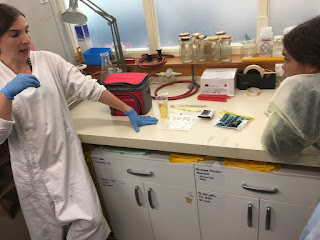Lakes380 day with Whanganui City College Year Nine students
 |
| Dr Mike Paki tells the story of Tainui, Turere and Ranginui to begin the Lakes380 day at Rotokawau - Virginia lake with Year Nine students from Whanganui City College |
The day began with introductions and a presentation of the Lakes380 project to the students in the hall of Whanganui City College. The students were then given the opportunity to work with the scientists at the lake side to collect and analyse samples of water, mud and DNA to better understand how the history of a lake can be built up from such original data. What amazed us all was when the scientists told us they were able to determine when eruptions occurred, when forests were felled and even when cyanobacteria and algae first appeared in a lake just by looking at the lake sediments. Stories would go back many years as you will read later.
 |
| Collecting an algae sample from Rotokawau -Virginia lake |

Our young scientists found out how to prepare a microscopic slide and identify an algae called....
 |
| Volvox |
The cyanobacteria (Anabaena) that has been identified in the lake is not at dangerous levels according to the Lakes380 scientists.
 |
| Anabaena cyanobacteria from Rotokawau -Virginia lake collected during teacher lake study (2018-19) |
And then we delved into the field of Forensic Biology! Believe it or not but from a water sample or mud sample the scientists can find a section of DNA and replicate this in the laboratory with polymerase enzyme until there is enough DNA to identify the organism and find out when it lived in the lake.
Then we moved on to the studies that were being made into the lake sediments. The Lakes380 Scientists informed us that a lake sediment core had not been extracted from Rotokawau - Virginia lake because this lake is reasonably well studied. Instead the scientists had spent some time that week working on Lake Westmere - Rotomokoia, just up the road from Virginia on SH3. Once upon a time Westmere water flowed into Virginia lake to provide old Whanganui town with water. Now it is surrounded by farmland and suffering from the same nutrient enrichment that has befallen Rotokawau - Virginia lake.
 |
| Students got to help with analysing the cores |
After our boys and girls identified grasses and wood in the Westmere mud, it was explained to them that grasses only appeared once the land had been cleared of trees and since these dates were documented in historical sources in Whanganui it was possible to determine the rate of sedimentation in the lake and hence, how quickly the lake was being filled in. This was scientific work with a strong historical and social connection.




The day continued along a cross-curricular theme when our young scientists interviewed the Lakes380 team to find out what their motivation was for being a scientist and working in lake science. The English Department had small filming units recording the day and we are hoping to present this film to the Whanganui public at the City Library very soon, along with the work the students have done in Science and Social Studies. This was a special day. A big thank you to the Lakes380 scientists for sharing their knowledge and expertise, the PTC for arranging the day and the Whanganui Chronicle for taking an interest in our studies
 |
| A future kaitiaki (environmental guardian) bids farewell to the Lakes380 team |









Comments
Post a Comment